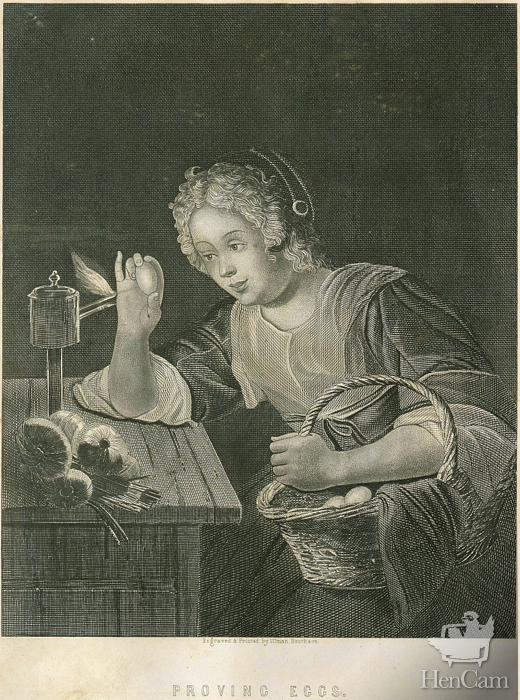Hold an egg up to a light and you can see what is going on inside. You can check infertile eggs for blood spots, and the shell for fine cracks. Fertile eggs can be inspected for signs of life and embryo development. Years ago, eggs were held up to a flame, today it’s more likely to be a flashlight or lightbulb, but this method is still called candling.
This print appeared in The Lady’s Friend, published in 1865.


Thank you so much for posting this vintage illustration, Terry. I inherited a brass lamp almost exactly like the one in the picture, except that it has a flat back and a decorative brass tab. It used to hang on a wall in my parent’s home, but I never knew that it was a lamp, or what it was for. I knew that it had to have a practical use (my father grew up on a farm where function was more important than form), but never knew what it could be – until now!
Amazing! You should try it out!
I knew about candling but was never sure what all was being looked for. So interesting. Proving Eggs seems about right. Do you know what this print was in reference to? An add? An article? Curious.
I love that Betsy went in and right over to Buffy. Later I saw her go over to Twinkydink when she came in. Seemed to be giving her an update on Buffy. Sweet.
The Lady’s Friend was a monthly women’s magazine, with stories, advice and fashion illustrations. This etching was not part of a larger article. I think it was simply meant to be a pretty thing, with a bit of underlying education.
As a young boy, about 55 years ago I helped my father who worked in a dairy store. One of my jobs was to candle the eggs. The store bought them in bulk an I not only candled them but sorted them by size for sale. At that time there was no such thing as prepackaged eggs in cartons. I think sometimes of building a candleing box but haven’t gotten around to it.
Enjoy the weekend
Here’s a question, Terry (actually it is my son-in-law’s question) – if there is a ‘double yolker’ egg, but it is fertilized, can there be twin chicks from that one egg?
Just wondering…….
Good question. It’s very rare, but it does happen that they begin to develop. However, from what I’ve heard, they never make it to hatching. There’s not enough room in the egg for them to grow.
Bingo. I tried it a couple times years ago both with in a incubator and with hens . I generally can suspect a double yolker by the size of the egg. I’d candle them and then set them. Generally nothing would develop but when it did development didn’t last long.
Thanks for this information. I love learning, especially about anything related to chickens or eggs. I so much enjoy your cams and blogs. I spend more time watching Buffy and friends than I spend on facebook or any other site. The candling practice is brand new to me. I’m so glad to hear of it. Thanks, again..
I think one of my New Hampshire’s laid a fetus. When I looked in the nesting box there were 2 eggs and an elongated somewhat c-shaped beige egg. But, it felt rubbery – no shell. After inspecting it, I could see a black dot/spot that could be the eye and the shape of a beak starting to develop. Have you ever experienced anything like this?
I had a rooster but, the neighbor’s dog took him down about a month before the hen laid the fetus.
That’s called a “lash.” It’s an compacted, infected egg mass. It’s a good thing that your hen passed it, as if it remains inside the reproductive tract, it can cause impaction and infection.
I have nine eggs in an incubator. I held 3 up to a flashlight and looks to me like a blob on my side of the egg. Does that mean the egg is fertile?
Should be! How many days along?
I am really dating myself but at school we had some old filmstrip projectors..they work like a charm at candling.
Genius!
13 days as of today. Some of them I can’t see through, and some look like a blob as I said. What do you think? I candled a fresh egg and you can see right through it.
You should see a web of blood vessels. If it’s just a blob, then the embryo has died. Do a google image search and you’ll find many photos that will help you determine what’s going on in your eggs.